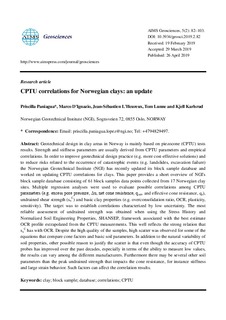CPTU correlations for Norwegian clays: an update
Paniagua Lopez, Ana Priscilla; D'Ignazio, Marco; L Heureux, Jean-Sebastien; Lunne, Tom; Karlsrud, Kjell
Peer reviewed, Journal article
Published version
Permanent lenke
http://hdl.handle.net/11250/2597364Utgivelsesdato
2019Metadata
Vis full innførselSamlinger
- NGI articles [1061]
Sammendrag
Geotechnical design in clay areas in Norway is mainly based on piezocone (CPTU) tests results. Strength and stiffness parameters are usually derived from CPTU parameters and empirical correlations. In order to improve geotechnical design practice (e.g. more cost-effective solutions) and to reduce risks related to the occurrence of catastrophic events (e.g. landslides, excavation failure) the Norwegian Geotechnical Institute (NGI) has recently updated its block sample database and worked on updating CPTU correlations for clays. This paper provides a short overview of NGI's block sample database consisting of 61 block samples data points collected from 17 Norwegian clay sites. Multiple regression analyses were used to evaluate possible correlations among CPTU parameters (e.g. excess pore pressure, Δu, net cone resistance, qnet, and effective cone resistance, qe), undrained shear strength (suC) and basic clay properties (e.g. overconsolidation ratio, OCR, plasticity, sensitivity). The target was to establish correlations characterized by low uncertainty. The most reliable assessment of undrained strength was obtained when using the Stress History and Normalized Soil Engineering Properties, SHANSEP, framework associated with the best estimate OCR profile extrapolated from the CPTU measurements. This well reflects the strong relation that suC has with OCR. Despite the high quality of the samples, high scatter was observed for some of the equations that compare cone factors and basic soil parameters. In addition to the natural variability of soil properties, other possible reason to justify the scatter is that even though the accuracy of CPTU probes has improved over the past decades, especially in terms of the ability to measure low values, the results can vary among the different manufacturers. Furthermore there may be several other soil parameters than the peak undrained strength that impacts the cone resistance, for instance stiffness and large strain behavior. Such factors can affect the correlation results. CPTU correlations for Norwegian clays: an update
